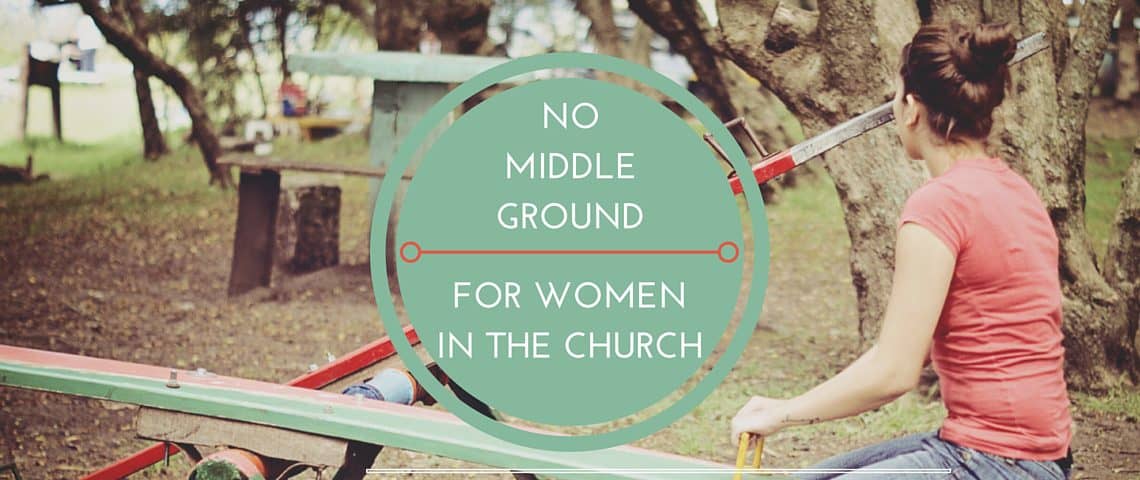When it was time for recess in grade school, I usually made a beeline for the seesaws. I loved flying up and then dropping suddenly to hit the ground with a thud. But I loved even more the challenge of keeping the seesaw suspended in mid-air with a playmate who weighed the same as I did. For some reason the gravitational stalemate gave me a sense of satisfaction. My fascination with playground physics was useful in helping me accept theological tensions such as the sovereignty of God and the free will of humans. I tried to hold two seemingly contradictory views together in balance.
There was a time I tried to keep both a hierarchical view of authority in the church and a freedom for women to use their Spirit-given gifts as they felt called by God. I had started wrestling through the issues of a woman’s place in the church. But I got caught in the middle where I was undecided about how far I would go along the spectrum of beliefs.
Moving Away from the Middle
I was certainly moving away from complementarian theology (women can only teach and lead women; husbands lead, wives submit) which took shape during Bible college and was reinforced in my church. Later I progressed to believing women could teach men and preach behind the pulpit.
But it was hard to cut the cord after nearly 30 years of believing the absolutist doctrine of ordained male leadership. Surely women could be truly valued and free under the authority of male elders. Godly male elders. Really really kind gentle male elders. And if they had a family, elders who loved their wives and daughters and therefore understood other women enough to pay attention to their voices in the community. (Hmmm…I could never figure out why single male elders were allowed despite the plain reading of 1 Timothy 3:2.)
I was trying to find a middle ground, that sweet spot on the seesaw that kept my complementarian theology balanced with my egalitarian heart. I even found a church that was trying to do the same thing with their soft complementarian position. They really believed it was possible for complementarians and egalitarians to worship and serve together in one community. I really wanted it to be possible too. But after six years of disappointments, I quit straddling the fulcrum between egalitarianism and complementarianism. I lifted my foot off the one side and planted both feet fully on the side of what I believed to be the real vision of the Kingdom. I couldn’t run fast enough down the plank to search for a fully egalitarian church, one with women elders, which I found.
The Metaphor Crashes
I love seesaws, but on the issue of women, the metaphor doesn’t work. I cannot be an egalitarian in a complementarian church anymore. As moderate as a soft complementarian church may be, it is still a hierarchy with power vested in men alone. Eventually my seesaw had to tip to one side or the other. I made the choice with full integrity as I searched through Scripture and with discernment in how the Spirit had been moving in my life all along.
The middle spot is unsustainable on this issue. Gravity will win and one side will crash.
- It will crash because theology and Bible interpretation has been and will continue to be a place of disagreement. Humans will always pick and choose what they want to believe and practice (more on that here). Churches that try the middle spot will find it is a place where theology is suspended or ignored or compromised. It doesn’t work for the long term because theology cannot be kept private when the practices of the church are public. A church cannot avoid practicing their doctrine of women. So complementarians walk out of services when a woman preaches and egalitarians grieve where women are absent or silenced.
- It will crash because we are sinful. Humans are limited and fallible and will always struggle with loving well. So there is no such thing as truly benevolent male elders. Sin has distorted perceptions of women as well as perceptions of men. The only way to overcome sin’s impact on gender relations is to distribute the power equally and create a leadership space where every voice has authority and choice to submit to one another. Without women in the room, hidden misogyny or damaging attitudes may not be exposed. As long as men hold absolute authority there is always the possibility for blind spots and an inability to hear women accurately. Maybe even the possibility of abuse. How can a church address justice issues in the world if it’s not willing to address justice issues in its own house?
- It will crash because we can’t rid ourselves of our cultural influences and agree upon one lens through which we view and interpret the world or Scripture. Humans will always have their biases. But many biases have changed through the course of history. Much of God’s will in heaven and the movement of the Spirit on earth is a mystery, but if we pay attention to what He has been doing through time, we can glimpse the path we should take culturally. If God created male and female to rule together at the beginning and if there is no gendered hierarchy in the new heavens and new earth, then the middle time of the church should be an increasing transformation into what God intended and will bring about in the end.
The transformation may be slow, but it’s unstoppable. And it’s better understood in hindsight. Luther’s Reformation tells us that the church got it wrong at one point. When it comes to women, they have it wrong again. But I believe there’s another reformation in the air. It may be hard to find evangelical, egalitarian churches now but I sense a tipping point ahead.
The seesaw has a slight tilt to one side.
———————————————————–
For another view on the tilting seesaw see 5 Signs that God May Be on the Move Regarding Women.
The soft complementarian position is explained by Craig Blomberg in Two Views on Women in Ministry. The doctrine loosens up some biblical passages while holding fast to others. Women are free to use their Spirit-based gifts in teaching and preaching but are excluded from positions that hold the highest levels of authority in the church (elder or senior pastor).
Image Credit: iStock




20 responses to “No Middle Ground for Women in the Church”
Thank you for your insights! Trying to be a part of both worlds just created a rub for me. Someone else deciding what was “allowed or not allowed” just didn’t work. In God comes everyone’s freedom for finding His gifts in us.
There is a Temporal and Spiritual side to everything. A hierarchy of position is of man and is helpful in Temporal administration. Righteousness is the Spiritual hierarchy and is much more important to Salvation.
Robert, I agree that a hierarchy of position is helpful for administration, which is why we do have leadership structures in place managing the affairs of our churches and businesses. But people should not be excluded from that hierarchy simple on the basis of gender. We should look at their talents, wisdom, experience, and spiritual gifting.
Exactly Gail! Leadership structures to make things run smooth, but with those in those positions because of their abilities and talents…not because they are a man or for that matter a woman. Just “people”, gifted, working side by side each other!
Karla, love your enthusiasm Thanks for making your voice heard here!
I loved and totally agree with this part: “It will crash because we are sinful.” I tend to hear how great complementarian relationships can be because ideally, men will love their wives enough to always listen to her and value her opinion and make decisions in her best interest. But if we are all sinful, both husbands and wives will fail each other so many times throughout their marriage. So ideal complementarianism seems highly unlikely to work, and more likely to create situations where women are victims because of the unbalance of power.
When submission isn’t mutual, and it’s only required from one half of a marriage or from half of the church, who do you think is going to end up the most negatively impacted by sin? Inevitably it’s the half that’s supposed to sit back and submit.
Again, I want to make it clear that I believe we are all sinners, but that’s just one more reason why a one-sided system is not a system we should be trying to put in place, because it’s more likely to not work than work.
So true! And hasn’t church history already shown it’s not working? I’m no prophet but I can’t help but believe the time is ripe for a new paradigm for church leadership, one that distributes power equally and unleashes both men and women together to image God and impact the world. Thanks for your thoughts!
Awesome, Harriett! We need to get together for coffee or lunch again and catch up… 🙂
Let’s do it!
I’d love to!
Fantastic article, with great insights. ‘It will crash because we are sinful’ – so true!
Natalie, I resonated with that argument as well and think it’s an important one to have more conversation about. I often hear from the complementarian camp that patriarchy works because the “patriarchs” behave in a benevolent fashion. But that premise is faulty, as Harriet so well points out.
My favourite points:
“As moderate as a soft complementarian church may be, it is still a hierarchy with power vested in men alone.”
“If God created male and female to rule together at the beginning and if there is no gendered hierarchy in the new heavens and new earth, then the middle time of the church should be an increasing transformation into what God intended and will bring about in the end.”
“The transformation may be slow, but it’s unstoppable. And it’s better understood in hindsight. Luther’s Reformation tells us that the church got it wrong at one point. When it comes to women, they have it wrong again. But I believe there’s another reformation in the air. It may be hard to find evangelical, egalitarian churches now but I sense a tipping point ahead.”
I think the seesaw really leans to one side or the other based on how a church answers the question, “Do men and women share authority and opportunities for service equally, or is there an imbalance?” If there is an imbalance, men will have more authority, women will have less–solely because they are women. If there is an imbalance, men will have more opportunities for service, women will have less–solely because they are women.
Thanks, Bob! Good question. This would certainly reveal which side a church is actually on. But if you find out your church is complementarian, do you leave or do you try to influence it to change? In my case I had really hoped to convince the well-intentioned church to abandon the middle spot and move more directly toward egalitarianism. I felt biblically it was the weakest place to be. But they would not even entertain a challenge to their hard work in studying the issue. So I wonder – What does it take to change a church’s position on women? Can it change or will the tilt only happen as more churches are planted with an egalitarian stance?
Bob, that first statement is really a key to this issue, isn’t it? I think we may need to have a graphic created with that quote on it! I also like the reminder that the church should always be moving towards redemption. As Christ prayed, “Your will be done, on earth as it is in Heaven”!
I really appreciate this piece, precisely because I tried to do the balance thing for a while and eventually tipped. Thanks!
And hopefully you have gained so much more clarity and peace as I did when I finally and wholeheartedly embraced equality!
“The transformation may be slow, but it’s unstoppable.”
Amen and Amen!!!
It sure does seems slow, doesn’t it, Anne? About twenty years ago a friend and I were talking about this, and she made the statement that she believed women would have to die before we would see real change in the church. Unfortunately, as I look at what’s happening to girls and women all around the world today, her prediction has come true. I believe there is a very real connection between gendercide, human trafficking, domestic violence, etc. and people’s “theology of women”. Let’s keep advocating for women, regardless of the cost! Thanks for entering into this important conversation.